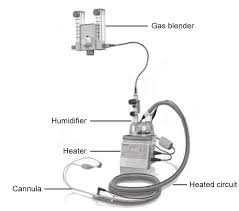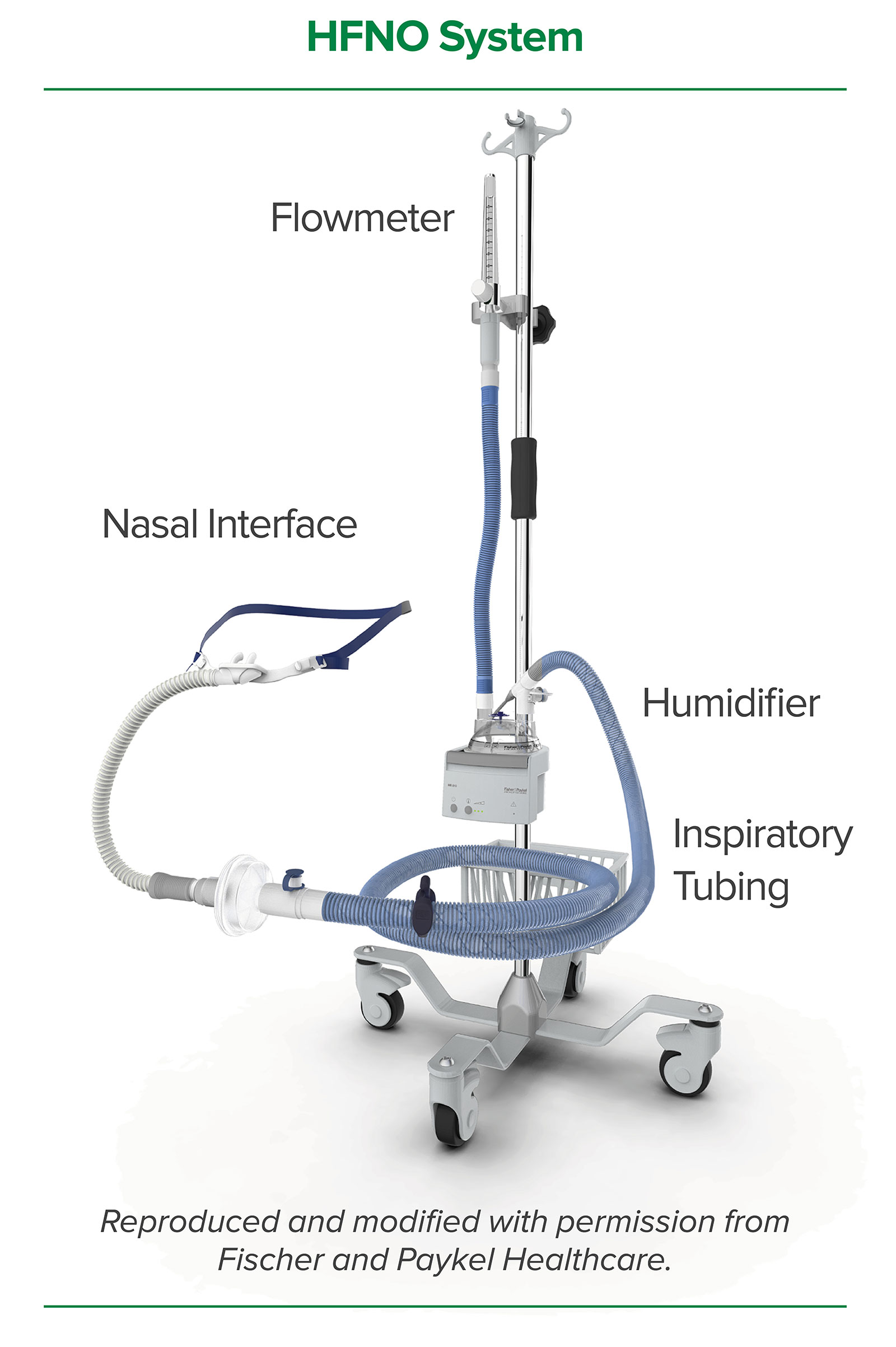heated high flow oxygen vs bipap
Oxygenation was shown to improve more with BiPAP than HFNC but arterial carbon dioxide PaCO2 was shown to decrease faster with HFNC. HFNC delivers flow not pressure like CPAP or BiPAP but the flow can generate an estimated 2-5 cm H 2 O of PEEP.

Nasal High Flow Therapy Versus Niv In Copd Patients With Chronic Respiratory Failure Youtube
95 CI -49 to 66.

. Oxygen therapy on the other hand is used to treat COPD and other chronic respiratory diseases. HFNC is more comfortable and studies have shown that using HFNC may be a better alternative than using a face mask. NIV provides positive end expiratory pressure PEEP by a tight-fitting mask.
They deliver oxygen at flow rates below the patients respiratory. High flow nasal cannula HFNC supportive therapy has emerged as a safe useful therapy in patients with respiratory failure improving oxygenation and comfort. Difference between High Flow Oxygen therapy and Ventilator in essence is the following.
Patients were randomized to receive HFNC vs. Heated high-flow nasal cannula HFNC oxygen is a safe and effective method of oxygenation. A randomized clinical trial.
Both high-flow and low-flow oxygen delivery systems are capable of administering a wide range of FiO 2However the terms high and low do not reflect the delivered FiO 2. Recently several clinical trials have analyzed the effectiveness of HFNC therapy in different clinical situations and have reported promising results. Comparison of High-flow Oxygen vs.
HFNC is a better oxygen delivery and respiratory support device than the standard non-rebreather oxygen mask venturi-mask and simple low flow nasal cannula in a hypoxic patient. Nasal CPAP and high-flow nasal cannula HFNC oxygen may improve the work of breathing and oxygenation. Continuous positive airway pressure CPAP therapy delivers a heated and humidified blend of air and oxygen while at the same time generating a continuous distending pressure throughout the respiratory cycle.
HFNC titrated to the highest flow rate that the patient could tolerate. No significant differences were found for intensive care unit mortality 23 patients with BiPAP 55 and 28 with high. NIV provides improved oxygenation and ventilation for patients who tolerate the mask.
Heated humidified high-flow nasal cannula HHHFNC has gained increasing popularity as respiratory support for newborn infants thanks to ease of use and improved patient comfort. The use of High Flow Nasal Oxygen HFNO remains contentious with different perspectives in how this modality can be used to treat respiratory failure in COVID-19. Many studies dont differentiate between the two though this is slowly changing in the medical field as randomized controlled trial evidence showed high velocity therapy to have outcomes comparable to Non-Invasive Positive.
High-flow nasal oxygen therapy was not inferior to BiPAP. 372218596 Stephan F Barrucand B Petit P et al. There was no difference in reintubation the primary outcome above.
High-flow nasal oxygen vs noninvasive positive airway pressure in hypoxemic patients after cardiothoracic surgery. BiPAP settings were adjusted to target a respiratory rate of 25 breathsminute adequate saturation and pH of 735. 95 CI 172-253 with high-flow nasal oxygen.
Current thinking suggests that NIV and HFNO may be an. Here we review the current knowledge about HFNC therapy. With BiPAP treatment failure occurred in 91 of 416 patients 219.
High-flow Nasal cannula consists of a specific machine and tubing used to deliver a very high flow of oxygen that is heated and humidified. High-flow oxygen through nasal cannula in acute hypoxemic respiratory failure. BiPAP for 24 hours after extubation.
Oxygen therapy involves only giving you additional oxygen your lung still does the activity of taking oxygen-rich air in and breathing carbon-di-oxide rich air out. The risk difference was 09 95 CI. NIV includes bilevel positive airway pressure BiPAP and continuous positive airway pressure CPAP.
However under certain conditions such as COPD-OSA overlap syndrome your doctor may advise you to use both of these therapies. In fact it refers to the flow of gas delivered to the system. N Engl J Med 2015.
Low-flow systems are used in more critically stable patients. BiPAP in Type II Hypercapnic Respiratory Failure The safety and scientific validity of this study is the responsibility of the study sponsor and investigators. HFNC can be delivered from 8-60Lmin 30-60 Lmin in adults and an FIO2 of 100.
Listing a study does not mean it has been evaluated by. CPAP BiPAP and APAP are used to treat obstructive sleep apnea one of the leading sleep disorders in the country. Heated humidified high-flow HHHF therapy often also high flow nasal cannulae HFNC or high flow nasal oxygen HFNO is a type of respiratory support method that delivers a high flow liters per minute of medical gas to a patient through an interface nasal cannulae intended to create a wash-out of the upper.
In infants with mild bronchiolitis there is no clinical or cost benefit in starting NHF as first-line treatment rather NHF is best used as a rescue therapy after standard oxygen. HFNC is primarily a flow generator and it is via high flow that it achieves its main beneficial effects of more reliably delivering a targeted F io 2 than standard oxygen supplementation although in a clinical setting accurate measurement of actual F io 2 delivered to the lungs is currently not possible and reducing dead space to improve ventilatory efficiency. A ventilator not only gives you additional oxygen it also does the work of your lungs breathe in out.
Vapotherm high velocity therapy often gets conflated with commodity high flow oxygen products also commonly known as High Flow Nasal Cannula HFNC. Nasal high flow is a form of non-invasive respiratory support that sits somewhere between standard oxygen therapy and nasal CPAP. The treatment failed in 87 of 414 patients with high-flow nasal oxygen therapy 210 and 91 of 416 patients with BiPAP 219 absolute difference 09.
95 CI 180-262 compared with 87 of 414 210. There was no change in mortality rates or intensive care unit hospital days between the two modes of oxygen delivery. High-flow nasal oxygen therapy was not inferior to BiPAP.
CPAP is the method of choice with the use of BiPAP for those with complex respiratory conditions who contract COVID-19. However its role as primary therapy for respiratory distress syndrome RDS of prematurity needs to be further elucidated by large randomized clinical trials. BiPAP did have higher rate of discontinuation of use and of skin breakdown.

How Does High Flow Nasal Cannula Hfnc Work Medmastery

High Flow Oxygen Therapy With Hamilton Medical Ventilators Youtube

High Flow Oxygen Therapy Hfot Armstrong Medical

China Hfnc High Flow Oxygen Therapy Nasal Oxygen Cannula Oxygen Therapy Machine With Air Compressor China Hfnc High Flow Oxygen

High Flow Oxygen Therapy Hfot Armstrong Medical

High Flow Oxygen Therapy Hfot Armstrong Medical

High Flow Oxygen Therapy Draeger

High Flow Nasal Cannula Youtube

Pin On Critical Care Senior Year

Why Not All High Flow Is The Same Vapotherm

High Flow Oxygen Therapy Draeger

High Flow Nasal Cannula Oxygenation Utilization In Respiratory Failure European Journal Of Internal Medicine

Equipment Used For The Nasal High Flow Oxygen Therapy System We Used A Download Scientific Diagram

Difference Between High Flow Oxygen Therapy And Ventilator

High Flow Oxygen Cuts Ventilator Use Speeds Covid Recovery Cidrap

40 Vs 60 L Min What S The Difference Between Vapotherm High Velocity Therapy And High Flow Nasal Cannula Vapotherm

Safe Use Of High Flow Nasal Oxygen Hfno With Special Reference To Difficult Airway Management And Fire Risk Anesthesia Patient Safety Foundation

References In High Flow Nasal Oxygen Therapy In Intensive Care And Anaesthesia British Journal Of Anaesthesia
